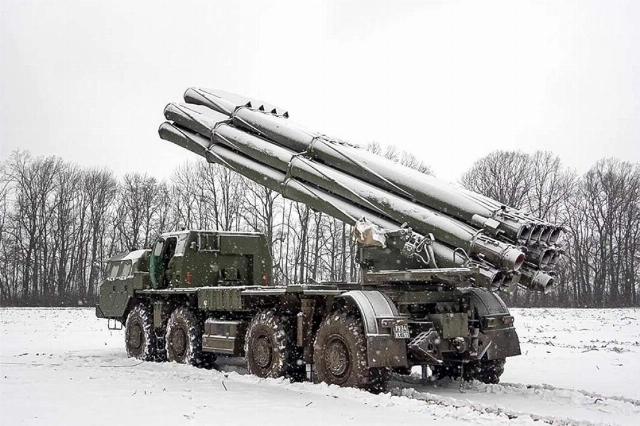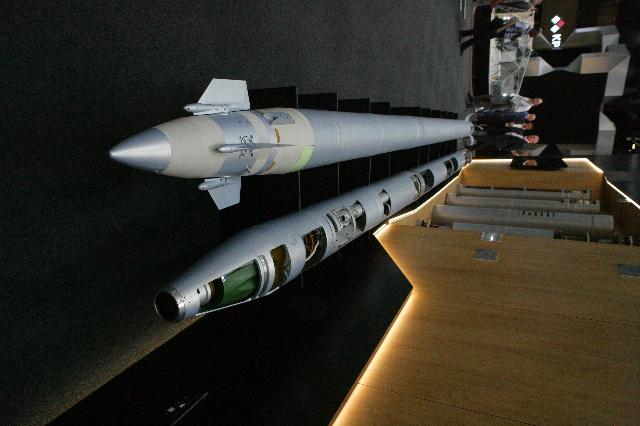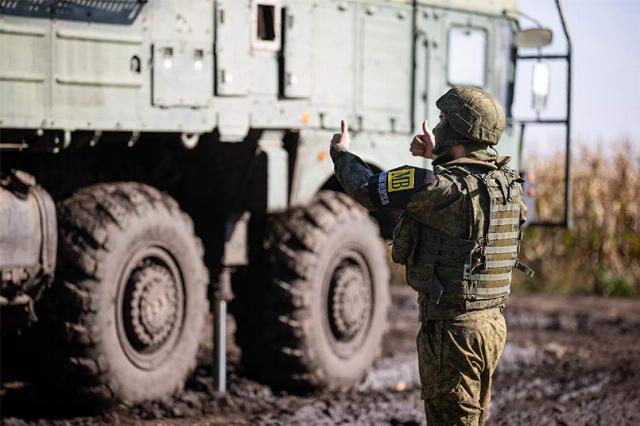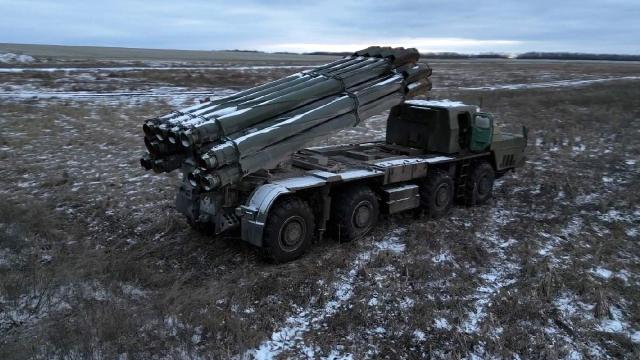The combination of detection and destruction means allows you to destroy any objects with high accuracy
On March 6, a video appeared on the telegram channels of Russian military commanders of the destruction of the HIMARS launcher by a homing missile of the Russian multiple launch rocket system (MLRS) "Tornado-S". The high-precision defeat was the result of the work of the reconnaissance and strike complex (RUK) using a reconnaissance drone. Izvestia looked into the capabilities of the Tornado-S smart missiles and what other systems and complexes can be used by the far-flung arms of the Russian Armed Forces against targets.
Destructive and highly accurate
The M142 HIMARS launcher of the Ukrainian Armed Forces was destroyed by a single high-precision hit about 40 km from the contact line near the settlement of Nikanorivka in the north of the Donetsk region controlled by Kiev. Reconnaissance and guidance were carried out from an unmanned aerial vehicle, which transmitted a video image of the target in real time to the fire control point of the Russian missile unit.
A high-precision rocket projectile with a high-explosive warhead was used on the M142. The munition was most likely equipped with a homing head, which allows you to identify a target on the ground and adjust the flight path for its direct defeat.

Tornado-S multiple launch rocket system
Image source: Photo: TASS/The press service of the Ministry of Defense of the Russian Federation
For several years, the corrected projectiles of the Tornado-S complex have also been equipped with satellite navigation systems that allow hitting targets with a deviation of no more than 5-10 m, but in this case the hit was exactly in the bull's eye. The high-explosive defeat of the equipped HIMARS machine caused the detonation of ammunition with the scattering of exploded missiles around the position of the Ukrainian launcher. With great probability, the car was completely destroyed and cannot be restored.
In the 2010s, the Tornado-S MLRS 9K515 received the first high-precision 9M544 cluster projectiles with a range of 120 km with a satellite guidance system. Each such munition is a large missile that carries 552 fragmentation—cumulative striking elements that destroy all unarmored and lightly armored targets in an area of several hundred square meters.
A little later, the 9M549 projectile appeared, equipped with a cassette with 72 striking bombs of higher power — such can penetrate the protection of armored personnel carriers and other armored vehicles. Cluster munitions effectively hit any defensive positions, headquarters, aviation equipment and air defense systems deployed on the ground. And so, apparently, a high-precision homing missile with a high-explosive warhead for pinpoint strikes appeared in the arsenal of Tornado-S. Now this multiple launch rocket system (MLRS) has a complete set of weapons, which makes the Tornado-C a more advanced MLRS in its capabilities than American complexes such as HIMARS and MLRS.

The 9M55K rocket to the RZSO "Smerch" and the guided missile 9M544 with cumulative fragmentation warheads to the RZSO "Tornado-S"
Image source: Photo: TASS/Ladislav Karpov
An attentive observer may note that since 2023, the number of cases of high-precision strikes by Tornado-C missiles that have become public has increased markedly. In recent months alone, we have witnessed the destruction of several positions of the Ukrainian S-300PM anti-aircraft system, as well as a hit by the NASAMS AFU air defense missile launcher in the village of Malyshevka north of Zaporozhye. A little earlier, footage was published of the destruction of the Czech RM-70 Vampire MLRS near the village of Petrovskoye and arrival at the rear point of the temporary deployment of the Armed Forces of Ukraine in the town of Selidovo, three dozen kilometers from Avdiivka. Enemy positions are guaranteed to be hit by the combined use of missiles with high-explosive and cluster warheads, which allows you to destroy a protected or armored object, as well as cover unprotected targets.
Tornado-C systems can play a huge role in solving issues of counter-battery warfare. MLRS are probably already being used in its interests, since such systems can suppress any modern artillery in terms of both range and striking ability. The only question is whether the rocket men get the necessary amount of high-precision ammunition.
Calculation of the Tor-M2 air defense system
Image source: Photo: TASS/The press service of the Ministry of Defense of the Russian Federation
The experience of the last months of the special military operation allows us to conclude that the Russian military-industrial complex has launched the production of the most advanced modifications of high-precision strike systems, and the armed forces have worked out the interaction of reconnaissance and strike complexes with their use. Recall that the concept of HANDS involves a combination of a high-precision defeat system and real-time reconnaissance systems. That is, the point of development of flight tasks for missile systems receives real-time information from a reconnaissance drone or from other information channels, creates a flight task and immediately transmits it to launchers that aim missiles and strike. Thus, the target can be hit within literally three to five minutes after detection.
In 2023, the Russian industry increased the production of weapons and military equipment in demand in its own region. During this year, more than 200 units of modern equipment are expected to be delivered to the troops as part of the state defense order. The Tornado-S and Tornado-G MLRS, Tor-M2 and Buk-M3 anti-aircraft missile systems, and other types of equipment will be delivered. The Tula production association "Alloy" has increased the production of guided missiles several times, including for complexes of the Tornado-S type. Probably, the increase in the proportion of high—precision lesions is just the result of this great work.
Not only Tornado-S
But the HAND can work not only with Tornado-S. On March 6, 2024, a ballistic missile of the Iskander-M complex was struck at a target in the port part of Odessa. With a high degree of probability, its application was planned taking into account the local situation — it was at this time that the awarding of servicemen of the Ukrainian Special Operations Forces (SSF) took place in Odessa. This kind of demonstration of the capabilities of the HANDS was held for the first time. And yes, missile strikes can indeed be coordinated in real time by both aerial and satellite reconnaissance, and, of course, by spotter scouts with access to the information transmission network.

Combat work of the Iskander-M OTRK
Image source: Photo: TASS/Stanislav Krasilnikov
Kamikaze drones of the Lancet type have become another striking means for using HANDS. Of course, such a drone can conduct independent hunting in search of targets, but its interaction with intelligence significantly increases the coverage of the area and allows you not to miss a single significant object. Most likely, this is how the first American M1 Abrams tanks of the Armed Forces of Ukraine were discovered and destroyed. The use of "smart" systems allows you to hit an important target with every shot, and here the possibilities that automated communication and information transmission systems that use reconnaissance and strike complexes give the modern army are manifested.
Dmitry Kornev

